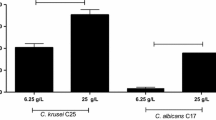Abstract
Purpose. This study examined the effects of cetylpyridinium chloride (CPC) on cell surface hydrophobicity (CSH) and adherence of blastospores of Candida albicans(MEN strain) to human buccal epithelial cells (EEC) in vitro.
Methods. The effect of CPC treatment of either C. albicans blastospores or BEC on their subsequent adherence was determined using 35SO4 labelled blastospores in association with a Percoll™ gradient. The effects of CPC treatment of blastospores on their CSH was determined using Hydrophobic Interaction Chromatography.
Results. Treatment of exponential and stationary phase blastospores with CPC (50 µg mL−1) for 0.5–30 minutes, or with CPC (0.5–50 µg mL−1) for 15 minutes resulted in significant reductions in both blastospore CSH and adherence to BEC in vitro. No correlation was apparent (r < 0.8) between reduced CSH and reduced blastospore adherence following treatment with CPC (0.5–50 µg mL−1). Significantly reduced adherence of C. albicans (stationary or exponential growth phases) to human EEC was also observed following treatment of BEC with CPC (50 µg mL−1) for 0.5–30 minutes or with CPC (0.5–50 µg mL−1) for 15 minutes. Antiadherence effects were observed at both sub and super-minimum inhibitory concentrations of CPC.
Conclusions. It is suggested that, whilst the ability of CPC to reduce the CSH of C. albicans may contribute to its reduced adherence to human BEC in vitro, reduced CSH is only one of several possible factors that contribute to the observed antiadherence effects.
Similar content being viewed by others
REFERENCES
Odds, F. C. Candida and Candidosis, A review and bibliography. Baliere Tindall, London, 1988, p 115–230.
Douglas, L. J. Adhesion of Candida species to epithelial surfaces. CRC Crit. Rev. Microbiol. 15:27–43 (1987).
Fowler, S. and Jones, D. S. Modified adherence of Candida albicans to human buccal epithelial cells in vitro following treatment with cationic, non-antibiotic antimicrobial agents. Int. J. Pharm. 86:193–199 (1992).
Critchley, I. A. and Douglas, L. J. Isolation and partial characterisation of an adhesin from Candida albicans. J. Gen. Micro. 133:629–636 (1987).
Gorman, S. P., McCafferty, D. F., Woolfson, A. D. and Jones, D. S. A comparative study of the microbial anti-adherence capacities of three antimicrobial agents. J. Clin. Pharm. Ther. 12:393–399 (1987).
Klotz, S. A., Drutz, D. J. and Zajic, J. E. Factors governing adherence of Candida albicans species to plastic surfaces. Infect. Immun. 50:97–101 (1985).
Hazen, K. C. Participation of yeast cell surface hydrophobicity in adherence of Candida albicans to human epithelial cells. Infect. Immun. 57:1894–1900 (1989).
Reinhart, H., Muller, G. and Sobel, J. D. Specificity and mechanism of in vitro adherence of Candida albicans. Ann. Clin. Lab. Sci. 15:406–413 (1985).
Kennedy, M. J. and Sandin, R. L. Influence of growth conditions on Candida albicans adhesion, hydrophobicity and cell wall ultrastructure. J. Med. Vet. Mycol. 26:79–92 (1988).
Ener, B. and Douglas, L. J. Correlation between cell-surface hydrophobicity of Candida albicans and adhesion to buccal epithelial cells. FEMS Microbiol. Letts. 99:37–42 (1992).
Schep, L. J., Jones, D. S., Schep, G. P. and Shepherd, M. G. A method to study the adherence of Candida albicans to human buccal epithelial cells in vitro using 35SO4 radiolabelled blastospores and a Percoll™ gradient. Int. J. Pharm. 105:39–45 (1994).
Schep, L. J., Jones, D. S. and Shepherd, M. G. Primary interactions of three Quaternary Ammonium Compounds with blastospores of Candida albicans (MEN Strain). Pharm. Res. 12:649–652 (1995).
Jones, D. S., Gorman, S. P., McCafferty, D. F. and Woolfson, A. D. The effects of three non-antibiotic, antimicrobial agents on the surface hydrophobicity of certain microorganisms evaluated by different methods. J. Appl. Bact. 71:218–227 (1991).
Bonesvoll, P. and Gjermo, P. A comparison between chlorhexidine and some quaternary ammonium compounds with regard to retention, salivary concentration and plaque-inhibiting effect in the mouth after mouth rinses. Arch. Oral Biol. 23:289–294 (1978).
Tobgi, R. S., Samaranayake, L. P. and MacFarlane, T. W. Adhesion of Candida albicans to buccal epithelial cells exposed to chlorhexidine gluconate. J. Med. Vet. Mycol. 25:335–338 (1987).
Rights and permissions
About this article
Cite this article
Jones, D.S., Schep, L.J. & Shepherd, M.G. The Effect of Cetylpyridinium Chloride (CPC) on the Cell Surface Hydrophobicity and Adherence of Candida albicansto Human Buccal Epithelial Cells in Vitro . Pharm Res 12, 1896–1900 (1995). https://doi.org/10.1023/A:1016231620470
Issue Date:
DOI: https://doi.org/10.1023/A:1016231620470




